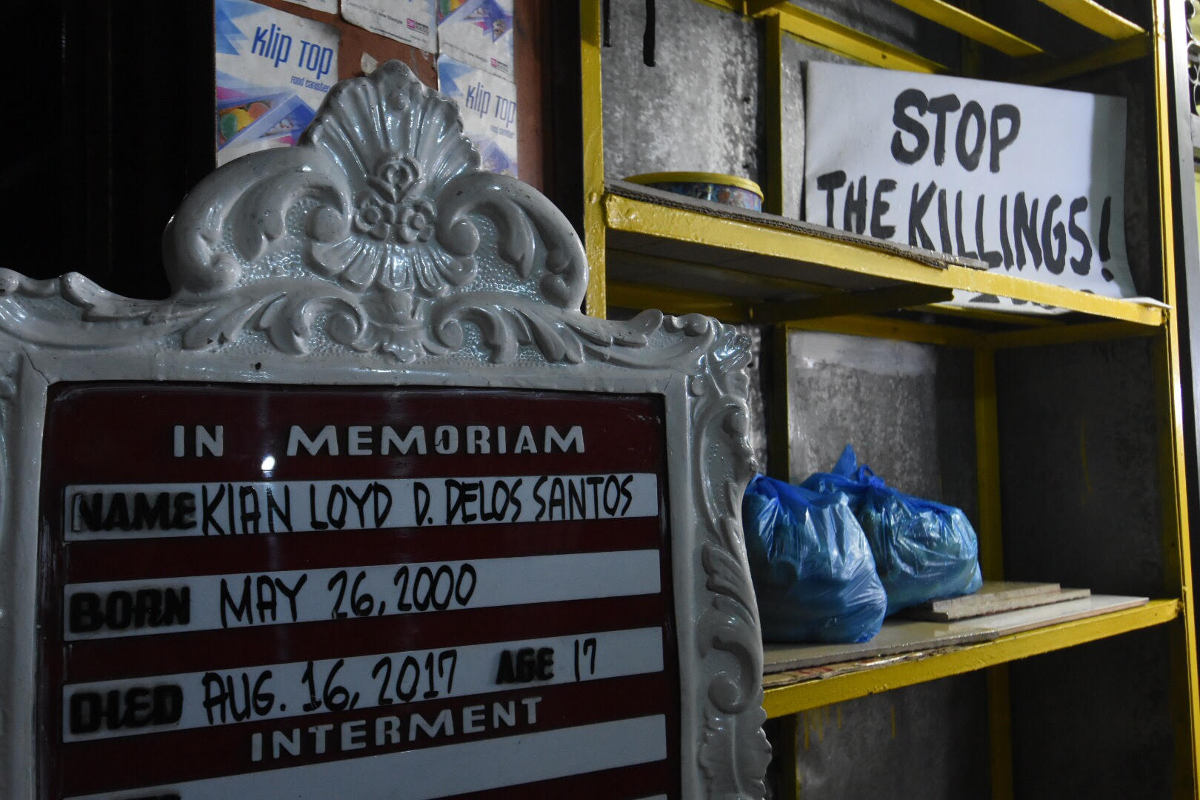“Show good manners or the police will arrest you.” This is what Filipino elderlies often say to scare off misbehaving children. What might seem as a simple disciplinary advice, however, has turned out to be a bloody reality among Filipino youth.
The killing of a 17-year-old high school student on the night of August 16 sparked nationwide protest. That student was Kian DeLos Santos who was assaulted by three plainclothes cops during an anti-illegal drug operation in the neighborhood of Caloocan City, Manila. Police claimed that Kian was involved in illegal drug activities and that he fired gunshots when he was being arrested, prompting them to fight back.
Neighbors of Kian and a CCTV installed near the crime scene, however, told a different version of the story. According to witnesses, they saw the three policemen frisking the teenager then beating him after not finding any incriminating evidence in his possession.
Witnesses said that they heard Kian begging the cops to stop, crying that he still has an examination to study for. They claimed the policemen gave Kian a pistol, ordering him to pull the trigger and run. Kian refused. Shortly after, gunshots were heard and the youth was found dead with two sachets of shabu on his body and .45 caliber pistol in his left hand despite being right-handed.
Meanwhile, the CCTV footage revealed an image of a young man, blindfolded and manhandled by the police. He was being led away to a corner where he was later found dead from gunshot wounds.
According to the forensic report of the Philippine National Police Crime Laboratory, Kian sustained two gunshot wounds in his head. The report further gave an indication that the teenager was already down at the time of the shooting.
“The trajectory of the bullets indicate that the shooter was standing while the victim is lying on the ground,” Dr. Erwin Erfe of the Public Attorney Office relayed during a Senate inquiry on August 24. Further, the PNP medico-legal examination did not find any gunpowder impact marking on Kian’s body, which suggests that he was shot point blank range or at close and direct contact.
According to the National Bureau of Investigation, the death of Kian was a case of intentional killing and ruled that the shabu and pistol found in his possession were planted.
Thus, criminal complaints were filed against the three police officers involved in the killing who were identified as PO3 Arnel Oares, PO1 Jeremias Pereda, and PO1 Jerwin Cruz. Also included in the complaint was station commander Chief Inspector Amor Cerillo.
The Filipino people condemned the Caloocan City police after Chief Senior Superintendent Chito Bersaluna revealed that the information regarding Kian’s involvement in illegal drugs was gathered from a social networking site.
Another victim of police atrocity was 19-year-old college student Carl Angelo Arnaiz. The following night after Kian’s death, August 17, Carl left his home to buy snacks but he never got home. After 10 days, his family reunited with his lifeless body found at a morgue in Caloocan.
Police reports said that Carl boarded a cab which he intended to rob. The taxi driver reportedly sought assistance when he chanced upon police personnel of the Caloocan police.
The cops claimed that Carl successively fired gunshots toward them, prompting them to retaliate “to suppress his unlawful aggression hitting him on his body that resulted in his instantaneous death.
Further, a police report dated August 30 said that the teenager was found with two packs of marijuana in his pocket and three packs of suspected shabu in his backpack.
A forensic examination of PAO, however, indicated otherwise. According to Erfe, there was no indication that Carl fired a gun but there were indications that he was tortured before being shot. The teenager sustained four gunshot wounds on his chest and one at the back of his right arm. The trajectory of gunshot wounds further revealed that Carl was kneeling or lying down when he was shot.
On the night of his disappearance, Carl’s family said that he was with his 14-year-old companion, Reynaldo de Guzman. The child was found dead with 30 stab wounds on his body and his head wrapped in packaging tape.
With the series of killings of Filipino youth, President Rodrigo Duterte is being urged to review the country’s policy regarding the war on drugs.
“Under President Duterte’s bloody war on drugs, there is a pattern of killing young and poor people, particularly innocent minors. There is a policy to kill,” lamented Senator Risa Hontiveros.
She further implored the people to demand the end to the abusive war on drugs of the administration as this “created this culture of killing and impunity in our country.”
Duterte, however, said that thinking that the government has a policy to kill is an insult. Earlier, he ruled out that Kian’s death was an isolated case.
An isolated case means that it is a singular incident, but statistics from Children’s Rehabilitation Center revealed that since Duterte became president and until August 20, there are at least 29 minors killed because of his infamous war on drugs.
Thus, progressive organizations decry the passage of Department Education Order no. 4, series of 2017 which serves as a guideline for the mandatory, random drug-testing of public and private high school students. The order commenced on September 1.
Janette Cawiding of the Alliance of Concerned Teachers said that considering the police atrocities in the incidents, the safety of students might become implicated as a result of the department order.
“We fear, in the lines of concerned teachers, that this will claim more lives and will give more license to the police to conduct Tokhang-like operations involving students, teachers, and personnel in the schools. Children are already being made of Tokhang even without drug-testing, what more if it is fully implemented in our schools?” said Cawiding. Tokhang refers to the local term pertaining to police anti-illegal drug operations.
As per the guidelines, the number and location of students to be tested will be based on the Stratified Cluster Sampling of Junior and Senior High School students. Further, a committee will be created at the Central Office to organize Random Drug Testing Teams.
Students selected for the drug testing will be required to accomplish a drug testing form. The specimens collected will be put under the custody of the Department of Health which will issue the result within 15 days.
Whether the result is negative or positive, it will remain confidential. The drug testing coordinator will inform only the parents and students about the result of the test.
The order further stressed that a positive confirmatory drug test result should not be a basis for the expulsion or any disciplinary action against the student. In addition, the result should not, in any way, be used to incriminate any student.
For students who tested positive, the concerned Drug Testing Coordinator will set a conference with the students, parents, and a DOH-accredited physician to discuss the issues of drug use and possible dependency.
The drug dependency of the students will also be identified and if found drug-dependent, a student will be referred to the Department of Social Welfare and Development. The family may also opt to send the student to a private rehabilitation center.




